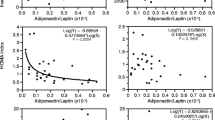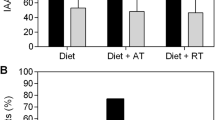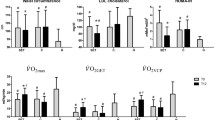Summary
Studies in recent years have shown beneficial effects of physical activity on lipid metabolism. Both serum lipids and lipids in adipose tissue and in skeletal muscle are affected.
Serum triglycerides are lowered by physical training. Results concerning serum cholesterol and free fatty acids (FFA) are still controversal. The concentrations of very low density lipoproteins (VLDL) and low density lipoproteins (LDL) are reduced and those of high density lipoproteins (HDL) are elevated. Thus LDL:HDL ratios and risk for atherosclerotic diseases are diminished. Epidemiologic studies showing a negative correlation between physical activity and coronary heart disease are congruent with these metabolic effects.
Physical training can reduce total body fat mass, and this reduction traced to a decreased fat cell size. In vitro investigations on this have implicated an impairment in lipogenesis. Methodological problems have clouded the results concerning lipolysis.
Comparing training-induced adaptive mechanisms in adipose tissue and skeletal muscle, different changes are evident. Whereas uptake and storage of lipids in adipose tissue is rather reduced, uptake and oxidation of lipids in skeletal muscle are enhanced. Thus a higher turnover of lipids in muscle lowers serum triglycerides and transport lipoproteins in trained patients with lipid disorders.
Other considerations notwithstanding, physical training is to be recommended for the reduction of VLDL and LDL triglycerides and total body fat mass. Moreover, an increase in HDL-cholesterol can be achieved.
Zusammenfassung
Untersuchungen in den letzten Jahren haben gezeigt, daß der Fettstoffwechsel durch körperliche Aktivität günstig beeinflußt wird. Diese Veränderungen betreffen sowohl die Serumlipide als auch Lipide im Fettgewebe und in der Skelettmuskulatur.
Körperliches Training führt zu einer ausgeprägten Senkung der Serumtriglyzeride. Eine Erniedrigung des Serumcholesterins und der freien Fettsäuren ist umstritten. Die Konzentrationen der „very low density“ Lipoproteine (VLDL) und der „low density“ Lipoproteine (LDL) werden vermindert, die der „high density“ Lipoproteine (HDL) vermehrt. Dadurch erniedrigt sich der LDL:HDL-Quotient und nach derzeitigen Vorstellungen das Arterioskleroserisiko. Entsprechend zeigen epidemiologische Untersuchungen eine negative Korrelation zwischen körperlicher Aktivität und koronarer Herzkrankheit.
Die Körperfettmasse kann durch körperliches Training aufgrund einer Verminderung der Fettzellgröße reduziert werden. In vitro-Untersuchungen am Fettgewebe zeigen, daß die Lipogenese auf mehreren Stufen gehemmt wird. Untersuchungsergebnisse hinsichtlich der Lipolyse sind aufgrund methodischer Probleme nicht einheitlich.
Beim Vergleich trainingsbedingter Adaptationsmechanismen im Fettgewebe und in der Skelettmuskulatur finden sich divergierende Stoffwechselveränderungen. Während im Fettgewebe Fetteinbau und Fettspeicherung eher vermindert sind, ist die Aufnahme und Oxydation von Lipiden in der Skelettmuskulatur des Trainierten beschleunigt. Dadurch kommt es bei trainierten Patienten mit Fettstoffwechselstörungen über einen beschleunigten Umsatz von Lipiden in der Muskulatur zu einer Senkung der Serumtriglyzeride und der Transportlipoproteine.
Körperliches Training kann bei Patienten empfohlen werden, bei denen eine Senkung der Triglyzeride in den VLDL und LDL, eine Erhöhung der HDL und eine Reduktion der Fettmasse wünschenswert ist, sofern keine Kontraindikationen gegen eine Bewegungstherapie bestehen.
Similar content being viewed by others
Literatur
Andres, R., Cader, G., Zierler, K.L.: The quantitative minor role of carbohydrate in oxidative metabolism by skeletal muscle in intact man in the basal state. Measurements of oxygen and glucose uptake and carbon dioxide and lactate production in the forearm. J. Clin. Invest.35, 671–682 (1956)
Askew, E.W., Huston, R.L., Plopper, C.G., Hecker, A.L.: Adipose tissue cellularity and lipolysis. Response to exercise and cortisol treatment. J. Clin. Invest.56, 521–529 (1975)
Askew, E.W., Huston, R.L., Dohm, G.L.: Effect of physical training on esterification of glycerol-3-phosphate by homogenates of liver, skeletal muscle, heart, and adipose tissue of rats. Metabolism22, 473–480 (1973)
Askew, E.W., Dohm, G.L., Doub jr. W.H., Huston, R.L., Van Natta, P.A.: Lipogenesis and glycerid synthesis in the rat: Response to diet and exercise. J. Nutr.105, 190–199 (1975)
Askew, E.W., Hecker, A.L., Coppes, V.G., Stifel, F.B.: Cyclic AMP metabolism in adipose tissue of exercise-trained rats. J. Lipid Res.19, 729–736 (1978)
Askew, E.W., Dohm, G.L., Huston, R.L., Sneed, T.W., Dowdy, R.P.: Response of rat tissue lipases to physical training and exercise. Proc. Soc. Exp. Biol. Med.141, 123–127 (1972)
Askew, E.W., Barakat, H., Kuhl, G.L., Dohm, G.L.: Response of lipogenesis and fatty acid synthetase to physical training and exhaustive exercise in rats. Lipids10, 491–496 (1975)
Bjernulf, A., Boberg, J., Fröberg, S.: Physical training after myocardial infarction. Metabolic effects during short and prolonged exercise before and after physical training in male patients after myocardial infarction. Scand. J. Clin. Lab. Invest.33, 173–185 (1974)
Björntorp, P., Berchtold, P., Grimby, G., Lindholm, B., Sanne, H., Tibblin, G., Wilhelmsen, L.: Effects of physical training on glucose tolerance, plasma insulin and lipids and on body composition in men after myocardial infarction. Acta Med. Scand.192, 439–443 (1972)
Björntorp, P., De Jounge, K., Sjöström, L., Sullivan, L.: Physical training in human obesity. II. Effects on plasma insulin in glucose-intolerant subjects without marked hyperinsulinemia. Scan. J. Clin. Lab. Invest.32, 41–45 (1973)
Björntorp, P., Holm, G., Jacobsson, B., Schiller-de Jounge, K., Lundberg, P.A., Sjöström, L., Smith, U., Sullivan, L.: Physical training in human hyperplastic obesity. IV. Effects on the hormonal status. Metabolism26, 319–328 (1977)
Borensztajn, J., Rone, M.S., Babirak, S.P., McGarr, J.A., Oscai, L.B.: Effect of exercise on lipoprotein lipase activity in rat heart and skeletal muscle. Am. J. Physiol.229, 394–397 (1975)
Brunner, D., Manelis, G., Modan, M., Levin, S.: Physical activity at work and the incidence of myocardial infarction, angina pectoris and death due to ischaemic heart disease. An epidemiological study in Israeli collective settlements (Kibbutzim). J. Chron. Dis.27, 217–222 (1974)
Campbell, D.E.: Influence of diet and physical activity on blood serum cholesterol of young men. Am. J. Clin. Nutr.18, 79–85 (1966)
Carlson, L.A., Mossfeldt, F.: Acute effects of prolonged heavy exercise on the concentration of plasma lipids and lipoproteins in man. Acta Physiol. Scand.62, 51–59 (1964)
Cassel, J., Heyden, S., Bartel, A.G., Kaplan, B.H., Tyroler, H.A., Cornoni, Hames, C.G.: Occupation and physical activity and coronary heart disease. Arch. Int. Med.128, 920–928 (1971)
Castelli, W.P.: High density lipoproteins: A new understanding of cholesterol and risk. Am. Heart Ass.'s Fourth Science Writers Forum, San Antonio, Texas, 1977
Cooper, K.H., Pollock, M.L., Martin, R.P., White, S.R., Linnerud, A.C., Jackson, A.: Physical fitness levels vs selected coronary risk factors. A cross-sectional study. J.A.M.A.236, 166–169 (1976)
Enger, S.C., Herbjørnsen, K., Erikssen, J., Fretland, A.: High density lipoproteins (HDL) and physical activity: the influence of physical exercise, age and smoking on HDL-cholesterol and HDL-/total cholesterol ratio. Scand. J. Clin. Lab. Invest.37, 252–255 (1977)
Ferguson, R.J., Côté, P., Gauthier, P., Bourassa, M.G.: Changes in exercise coronary sinus blood flow with training in patients with angina pectoris. Circulation58, 41–47 (1978)
Ferguson, R.J., Petitclerc, R., Choquette, G., Chaniotis, L., Gauthier, P., Huot, R.F., Allard, C., Jankowski, L., Campeau, L.: Effect of physical training on treadmill exercise capacity, collateral circulation and progression of coronary disease. Am. J. Cardiol.34, 764–769 (1974)
Fox, S.M., Haskell, W.L.: Physical activity and the prevention of coronary heart disease. Bull N.Y. Acad. Med.44, 950–967 (1968)
Glomset, J.A.: The plasma lecitin: Cholesterol acyltransferase reaction J. Lipid Res.9, 155–167 (1968)
Havel, R.J., Naimark, A., Borchgrevink, C.V.: Turnover rate and oxidation of free fatty acids of blood plasma in man during exercise: Studies during continuous infusion of palmitate - 1 -14C. J. Clin. Invest.42, 1054–1063 (1963)
Hinkel, L.E., Carver, S.T., Stevens, M.: The frequency of asymptomatic disturbances of cardiac rhythm and conduction in middle-aged men. Am. J. Cardiol.24, 629–650 (1969)
Hoffmann, A.A., Nelson, W.R., Goss, F.A.: Effects of an exercise program on plasma lipids of senior air force officers. Am. J. Card.20, 516–524 (1967)
Holloszy, J.O., Skinner, J.S., Toro, G., Cureton, T.K.: Effects of a six month program of endurance exercise on the serum lipids of middle-aged men. Am. J. Cardiol.14, 753–760 (1964)
Holloszy, J.: Biochemical adaptations in muscle. Effects of exercise on mitochondrial oxygen uptake and respiratory enzyme activity in skeletal muscle. J. Biol. Chem.242, 2278–2282 (1967)
Johnson, R.H., Walton, J.L., Krebs, H.A., Williamson, D.H.: Metabolic fuels during and after severe exercise in athletes and non-athletes. Lancet2, 452–455 (1969)
Kemmer, F.W., Berger, M., Herberg, L., Gries, F.A.: Effects of physical training on glucose tolerance and on glucose metabolism of isolated skeletal muscle in normal rats. (Abstract) Diabetologia13, 407 (1977)
Keul, J., Doll, E., Haralambie, G.: Freie Fettsäuren, Glycerin und Triglyeride im arteriellen und femoral-venösen Blut vor und nach einem vierwöchigen Training. Pflügers Arch.316, 194–204 (1970)
Kirkeby, K., Strömme, S.B., Bjerkedal, I., Hertzenberg, L., Refsum, H.E.: Effects of prolonged, strenuous exercise on lipids and thyroxine in serum. Acta Med. Scand.202, 463–467 (1977)
Koschinsky, T., Carew, T.E., Steinberg, D.: Effects of high density lipoprotein and low density lipoprotein metabolism by pig smooth muscle cells (Abstract). Circulation52, 273 (1975)
Lampman, R.M., Santinga, J.T., Hodge, M.F., Block, W.D., Flora, J.D., Bassett, D.R.: Comparative effects of physical training and diet in normalizing serum lipids in men with type IV hyperlipoproteinemia. Circulation55, 652–659 (1977)
Le Blanc, J., Boulay, M., Dulac, S., Jobin, M., Labrie, A., Rousseau-Migneron, S.: Metabolic and cardiovascular responses to norepinephrine in trained and nontrained human subjects. J. Appl. Physiol.42, 166–173 (1977)
Lehtonen, A., Viikari, J.: The effect of vigorous physical activity at work on serum lipids with a special reference to serum high-density lipoprotein cholesterol. Acta Physiol. Scand104, 117–121 (1978)
Lopez-S., A., Vial, R., Balart, L., Arroyave, G.: Effect of exercise and physical fitness on serum lipids and lipoproteins. Atherosclerosis20, 1–9 (1974)
Lopez-S., A., René, A., Bell, L., Herbert, J.A.: Metabolic effects of exercise. I. Effect of exercise on serum lipids and lipogenesis in rats. Proc. Soc. Exp. Biol. Med.148, 640–645 (1975)
Malinow, M.R., McLaughlin, P., Pierovich, I.: Muscular activity and the degradation of cholesterol by the liver. Atherosclerosis15, 153–162 (1972)
Miller, N.E., Miller, G.J.: High density lipoprotein and atherosclerosis. Lancet1, 16–19 (1975)
Molé, P.A., Oscai, L.B., Holloszy, J.O.: Adaptation of muscle to exercise. Increase in the levels of palmityl CoA synthetase, carnitine palmityltransferase, and palmityl CoA dehydrogenase, and in the capacity to oxidize fatty acids. J. Clin. Invest.50, 2323–2330 (1971)
Morgan, T.E., Short, F.A., Cobb, L.A.: Effect of long-term exercise on skeletal muscle lipid composition. Am. J. Physiol.216, 82–86 (1969)
Morris, J.N., Heady, J.A., Raffle, P.A.B., Roberts, C.G., Parks, J.W.: Coronary heart disease and physical activity of work. Lancet2, 1053–1057 (1953)
Naito, H.K., Griffith, D.R.: Change in rats serum triglyceride concentration with graded levels of thyroxine and exercise. Proc. Soc. Exp. Biol. Med.154, 372–376 (1977)
Nikkilä, E.A., Taskinen, M.R., Rehunen, S., Härkönen, M.: Lipoprotein lipase activity in adipose tissue and skeletal muscle of runners: Relation to serum lipoproteins. Metabolism27, 1661–1671 (1978)
Oscai, L.B., Patterson, J.A., Bogard, D.L., Beck, R.J., Rothermel, B.L.: Normalization of serum triglycerides and lipoprotein electrophoretic patterns by exercise. Am. J. Card.30, 775–780 (1972)
Owens, J.L., Fuller, E.O., Nutter, D.O., Digirolamo, M.: Influence of moderate exercise on adipocyte metabolism and hormonal responsiveness. J. Appl. Physiol.43, 425–430 (1977)
Paffenbarger, R.S., Hale, W.E.: Work activity and coronary heart mortality. N. Engl. J. Med.292, 545–550 (1975)
Palm, J.: Der sanfte Weg zur Fitneß. Dtsch. Ärztebl.75, 2915–2993 (1978)
Palmer, W.K., Tipton, C.M.: Effect of training on adipocyte glucose metabolism and insulin responsiveness. Fed. Proc.33, 1964–1968 (1974)
Parizková, J., Stanková, L.: Influence of physical activity on a treadmill on the metabolism of adipose tissue in rats. Br. J. Nutr.18, 325–331 (1964)
Parizková, J.: Impact of age, diet and exercise on man's body composition. Ann. N.Y. Acad. Sci.110, 661–674 (1963)
Paul, P.: Effects of long lasting physical exercise and training on lipid metabolism. In: Metabolic adaptation to polonged physical exercise. Howald, H., Poortsmans, J.R. (eds.), p. 156–193. Basel: Birkhäuser 1975
Rosing, D.R., Brakman, P., Redwood, D.R.: Blood fibrinolytic activity in man: Diurnal variation and the response to varying intensities of exercise. Circ. Res.27, 171–184 (1970)
Roskamm, H., Samek, L.: Die Bedeutung des Sports in der Therapie der koronaren Herzerkrankung. Dtsch. Ärztebl. 3039–3044 (1978)
Sannerstedt, R., Wasir, H., Henning, R., Werköl, L.: Systematic hemodynamics in mild arterial hypertension before and after physical training. Clin. Sci. Mol. Med. (Suppl.)45, 45–49 (1973)
Schettler, G., Silberberg, N.: Fettstoffwechsel und körperliches Training mit besonderer Berücksichtigung der koronaren Herzkrankheit. Therapiewoche27, 9072–9092 (1977)
Shepherd, R.E., Sembrowich, W.L., Green, H.E., Gollnick, Ph.D.: Effect of physical training on control mechanisms of lipolysis in rat fat cell ghosts. J. Appl. Physiol.42, 884–888 (1977)
Simko, V., Ondreicka, R., Chorvathova, V., Bobek, P.: Effect of long-term physical exercise on bile sterols, faecal fat and fatty acid metabolism in rats. J. Nutr.100, 1331–1340 (1970)
Simonelli, C., Eaton, R.P.: Reduced triglyceride secretion: A metabolic consequence of chronic exercise. Am. J. Physiol.234, E221-E227 (1978)
Taylor, A.W., Cary, S., McNulty, M., Garrod, J., Secord, D.C.: Effects of food restriction and exercise upon the deposition and mobilization of energy stores in the rat. J. Nutr.104, 218–222 (1974)
Wahren, J., Felig, P., Hagenfeldt, L.: Physical exercise and fuel homeostasis in diabetes mellitus. Diabetologia14, 213–222 (1978)
Watt, E.W., Wiley, J., Fletcher, G.F.: Effect of dietary control and exercise training on daily food intake and serum lipids in postmyocardial infarction patients. Am. J. Clin. Nutr.29, 900–904 (1976)
Wirth, A., Neermann, G., Eckert, W., Heuck, C.C., Weicker, H.: Metabolic response to heavy physical exercise before and after a 3-months-training period. Eur. J. Appl. Physiol.41, 51–59 (1979)
Wirth, A., Holm, G., Lindstedt, G., Lundberg, P.A., Björntorp, P.: Thyroid hormones in the physically trained rat. J. Appl. Physiol. (im Druck)
Wood, P.D., Haskell, W., Klein, H., Lewis, S., Stern, M.P., Farquhar, J.W.: The distribution of plasma lipoproteins in middle-aged male runners. Metabolism25, 1249–1257 (1976)
Author information
Authors and Affiliations
Rights and permissions
About this article
Cite this article
Wirth, A., Schlierf, G. & Schettler, G. Körperliche Aktivität und Fettstoffwechsel. Klin Wochenschr 57, 1195–1201 (1979). https://doi.org/10.1007/BF01489246
Received:
Accepted:
Issue Date:
DOI: https://doi.org/10.1007/BF01489246




